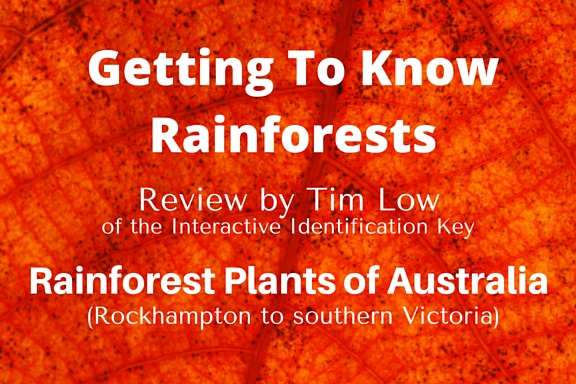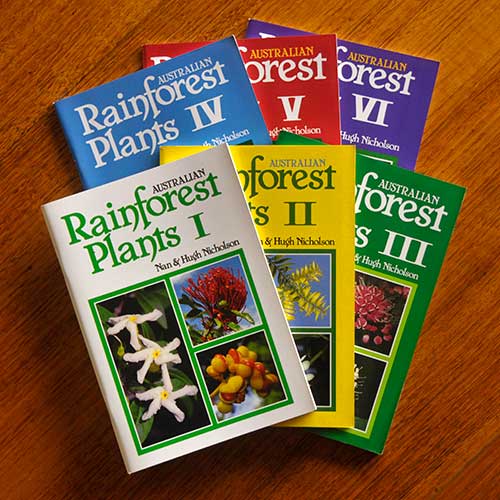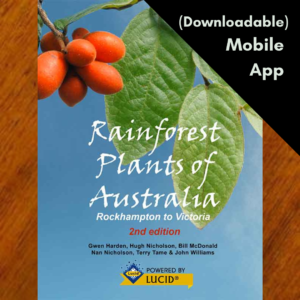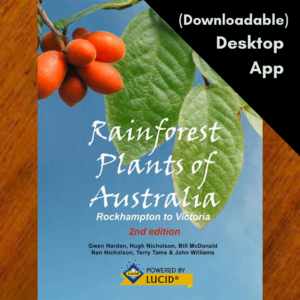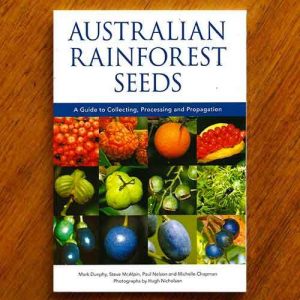Getting To Know Rainforests
Review of interactive key:
Rainforest Plants of Australia – Rockhampton to Victoria
by Tim Low
Identification of rainforest plants has become much easier with the arrival of an impressive new identification guide. Those who are into rainforest will be familiar with the two guides for temperate Australia, Rainforest Trees and Shrubs and Rainforest Climbing Plants. The authors of these works have combined with Hugh and Nan Nicholson, well-known for their colourful booklets about rainforest plants, to produce the ultimate identification guide, on a USB stick that incorporates a Lucid key.

1. Smyrell’s Clausena (Clausena smyrelliana) is a critically endangered shrub known only from an area around Bundaberg in southern Queensland, and only from four sites, including one at which it has not been seen since 1920.
Every rainforest tree, shrub and creeper from Rockhampton to Victoria is covered in detail. As well as text, there are, for example, 11 photos and four drawings of cockspur thorn, showing the male and female flowers, fruit, leaves, milky latex, spines, branches and trunk, and even the yellow discoloured patches often seen on the leaves. All up, there are 12,000 photos of the 1139 species, and drawings on top of that.
What is obvious from this guide is that those producing it not only know the plants, they know how to produce guides. That this on took them ten years is not surprising. Everything about it is user friendly.

2. Named in 1997, Springbrook Pinkwood, (Eucryphia jinksii) is in a relict Gondwanan genus shared by Australia and South America. Confined to the McPherson Range on the Queensland-NSW border, this endangered tree has its nearest relatives in southern NSW and north Queensland.
The key allows the user with only a sprig of leaves to generate a list of possible names by choosing from among a large number of features. Leaf characters are especially important given that rainforest trees c日本藤素
an go years without flowering and produce their blossoms high in the canopy. Plants with unusual features are especially easy to identify with the key. I typed in ‘climber’ with ‘spines and prickles’ that are ‘scattered along the stems’ and received 28 choices, on which I could click to see line drawings and colour photos. There is no easier way to identify plants.

3. This Backhousia has yet to receive a scientific name because its flowers and fruits remain unrecorded. It is confined to the Mt Morgan district south-west of Rockhampton, where it was discovered during fieldwork undertaken for this USB.
The terms used are clearly defined and illustrated, so that when the Lucid key asks if the veins on your leaf are ‘prominent’ , ‘very prominent’, ‘distinct’ or ‘obscure’, each choice is clearly defined and linked to photos that show them.

4. This mistletoe (Amyema plicatula), found growing on two Rosewood trees in northern NSW, is otherwise known only from Mt Lewis in north Queensland and in New Guinea.
The authors have included large numbers of species that have yet to receive a scientific name. You can read all about Samadera species ‘Mt. Goonaneman’ confined to the vicinity of Maryborough, and an undescribed species Acalypha and Phyllanthus from near Miriam Vale in central Queensland. Undescribed plants are often so rare they need special protection, but when they are missing from books they are apt to be neglected. This guide gives them generous coverage. It also includes more than a hundred weeds which have now become part of the rainforest flora.

5. The critically endangered Nightcap Oak (Eidothea hardeniana), named after one of the authors of the guide, Gwen Harden, represents an ancient lineage that predates the separation of Africa proteas from their Australian relatives.
I can understand why a Kew botanist called Rainforest Plants of Australia ‘the Rolls-Royce of botanical identification keys’. It is not cheap, but it is good. Anyone with an itch to know more about rainforest should get it.
About Tim Low.
Tim Low’s reports, books, articles and talks have contributed to ecological thought and environmental policy in Australia and more widely.
Written for a general audience, his books have attracted broad academic interest and serve as recommended reading in many university courses.
You can find him and his work at www.timlow.com

